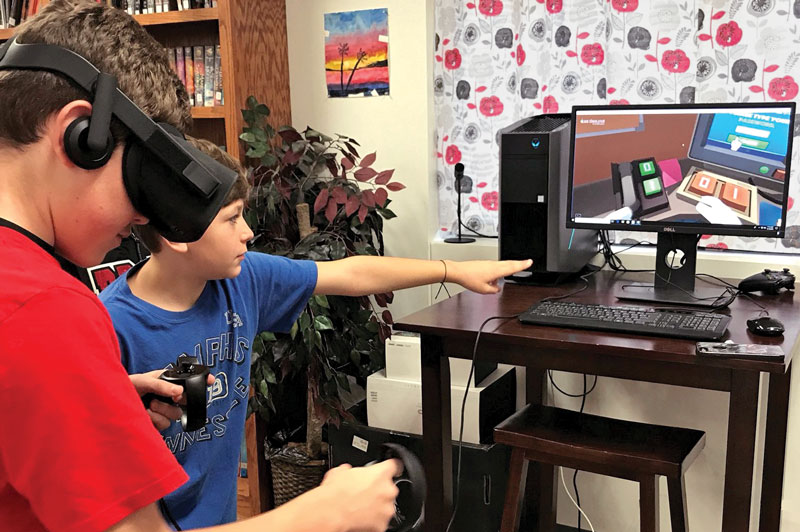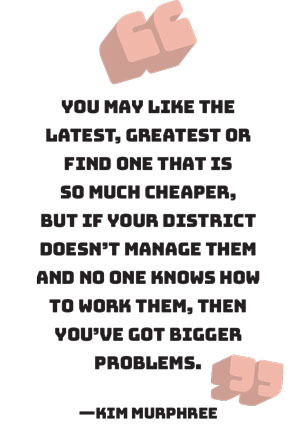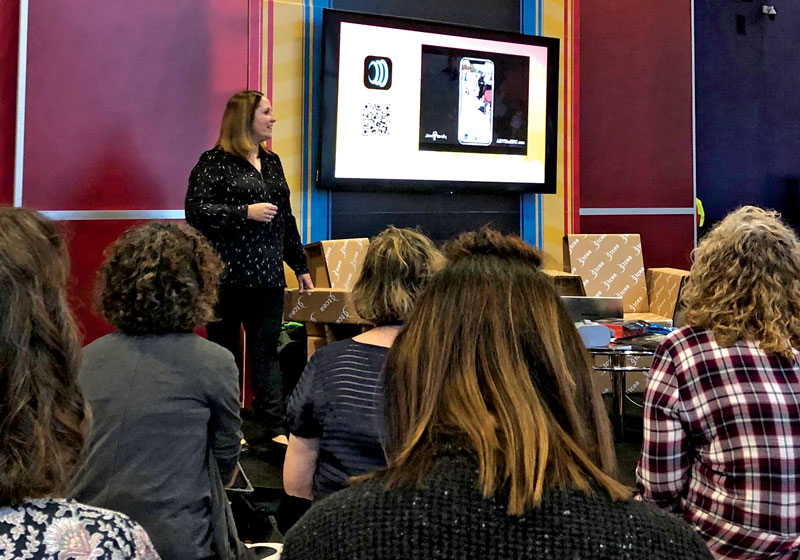Get the Most from AR/VR Technology Without Breaking the Budget
For school librarians planning for a return to in-school programming, peers share their AR/VR programming, mistakes made along the way, and the best way to incorporate the mixed reality edtech into the library and classroom.
 |
Alicia Turley’s students at Rose Bud (AR) High School use an Oculus Rift virtual reality headset.Photo by Alicia Turley |
When Kim Murphree first got her hands on a virtual reality set, the educational technology trainer was excited to begin helping teachers in her Mansfield (TX) Independent School District use the technology in classrooms. After researching options that fit their grant-funded budget, Murphree and her team purchased plastic headsets and augmented reality (AR) and virtual reality (VR) compatible ASUS ZenFones. They set up a checkout system so teachers at the 46 Mansfield schools could take advantage of applications like viewing and creating 360-degree video and Google Expedition virtual tours and trips. But Murphree began to notice that their initial investment didn’t last long.
“When we first got them, we thought it was the coolest thing ever,” Murphree says. “And then about six months later, they were cracked and the foam that was around the eyepiece was half hanging off.”
 That was about five years ago when immersive technology, including AR/VR, started to enter schools and learning spaces. As the technology hub on most school campuses, libraries quickly became the home for VR and AR programs. These tools don't translate well for remote learning, but will be back in use when schools reopen across the country. Librarians, media specialists, and technology trainers have been experimenting with connecting VR to curriculum and students in a meaningful way—and also ensuring it doesn’t become a secondary, expensive piece of wasted technology.
That was about five years ago when immersive technology, including AR/VR, started to enter schools and learning spaces. As the technology hub on most school campuses, libraries quickly became the home for VR and AR programs. These tools don't translate well for remote learning, but will be back in use when schools reopen across the country. Librarians, media specialists, and technology trainers have been experimenting with connecting VR to curriculum and students in a meaningful way—and also ensuring it doesn’t become a secondary, expensive piece of wasted technology.
“You don’t want it to turn into fluff or something extra,” Murphree says.
VR first targeted the individual consumer for home entertainment. The Oculus Rift was originally priced around $600 for the headset alone.
“The ability to have these immersive experiences for so many kids was not really something that you could do more than five years ago,” Murphree says. “It was out of the financial range of most schools.”
But around 2014, Jaime Donally, a VR and AR immersive technology specialist based in Texas, noticed a window of opportunity for educators to adopt the technology.
“I started watching where the funding was going, and it was targeted more toward gamified entertainment,” Donally says. “I thought this was something that was going to change the landscape.”
As technology advanced, more headsets and software became available at varying price points and with different capabilities. But even with cheaper options, there are many questions to consider before committing to AR/VR.
First, do your research, says Donally. Every district, school, and student has unique needs, and it’s important to evaluate whether or not the technology matches those needs.
“Sometimes it’s AR and VR that can meet those needs, and sometimes it’s not,” Donally says.
 |
student in Amery (WI) School District learns with the HTC Vive Pro.Photos by Raymond Buenzli (AHS student) |
Certain subjects may be well suited for VR and AR, while others may require more creativity to implement or may not be a natural fit. Identifying the learning gaps and objectives can help you shape a more personalized program, Donally says.
When Katie McNamara, a teacher librarian at Kern North High School in Bakersfield, CA, contemplates integrating any new technology at the library, she looks at its ability to allow students to create.
“I want my students taking what they’re learning, making something, and then sharing that with others to make a difference,” McNamara says. For example, in one assignment, students make study guides using Metaverse, a free AR app that does not require a headset. Then they’ll share the guides with the rest of the class. In another project, students create an interactive AR recommendation of books to read in the library.
McNamara has developed her program—which uses a couple of Merge viewers ($39) and free online apps—with minimal funding and physical space. Even for those with a sizable budget, some VR can still be prohibitively
expensive. All-in-one headsets that do not require a phone to use can range from $399 (Oculus Rift) to $9,000 (VRHero 5K Plus). You may have to budget for additional costs if the headset doesn’t come with features, such as motion controllers, wireless adapters, and computers with specific graphics cards and operating system requirements.
“People feel like they have to have a headset,” says Donally. “I think there are levels of virtual reality.”
Donally advises finding out if the technology supports the VR and AR you want. If you can run an experience on a tablet, Chromebook, or iPod Touch, then consider using just the device. For a step up, slot an Android or iPhone into a viewer like Google Cardboard, she says.
 But beware of the cost of going too cheap. Incompatibility with the operating systems already in place at your school can turn into an unexpected problem down the road.
But beware of the cost of going too cheap. Incompatibility with the operating systems already in place at your school can turn into an unexpected problem down the road.
“You may like the latest, greatest or find one that is so much cheaper, but if your district doesn’t manage them and no one knows how to work them, then you’ve got bigger problems,” says Murphree.
In addition to the durability problem with the initial plastic viewers, Murphree found that the ASUS ZenFones wouldn’t fit into headsets when they had cases on. Her team had looked at the cheapest replacement options but found they would run into the same issues. Instead, they now have 60 Merge headsets, which are constructed with flexible, antimicrobial material foam, and movable lenses. They have not had a problem, says Murphree.
Lower-level VR programs have limitations, says Greta McCarty, a library media specialist and technology integration specialist at Amery (WI) School District.
“I know a lot of schools really love the type of virtual reality where you put your phone or something in as your screen, but I was looking for something a little more powerful,” she says. “I just wasn’t ready to spend a lot of money for something I wasn’t excited about.”
Last year, McCarty chose the HTC Vive Pro ($599) for the district’s high school. Students in fashion design are assigned to use Tilt Brush by Google to create videos, virtual landscapes, and animations, while students in science courses are taught and tested with 3D Organon VR Anatomy, a medical app that allows users to view, interact with, and learn about the human body. Both of these apps are available only for certain HTC Vive, Oculus, Valve Index, and Windows Mixed Reality headsets.
According to McCarty, the anatomy teacher told her that purchasing a model for the classroom would be thousands of dollars more and not have the level of detail found in the app.
For equipment that is more expensive, McCarty recommends starting with one device, maybe two. Research what you can afford and support, but also budget for future expansion, repairs, and upgrades, she says.
The technology is popular, and McCarty turns to her students for help with demand and adding apps. She runs an independent studies class where students helped her set up and pilot the system. Whenever McCarty has a new app she wants to try, the students test it first, then show her and other teachers how to use it.
“It’s really given some students a lot of ownership,” McCarty says. “That helps my programming because I can only do so much myself, but they become another advocate and then the students see what they get to do.”
Spreading awareness about VR across the school is essential to keeping a program alive. At Rose Bud (AR) High School, library media specialist Alicia Turley has had no trouble getting students interested in VR.
“They tell their friends and then they tell their friends, and before long it’s just a library full of kids,” she says. But sometimes it’s not as easy to get teachers on board.
She sends updates when she gets a new app that may be relevant to their classes, but sometimes she must do more. For example, she thought Oculus Rift’s Wonderful You, which takes users on a virtual journey through the development of babies and the five senses, would be perfect for the home economics classes.
“To get the home ec teacher in, I had to go down there and say, ‘This is your prep period, come with me. Just come with me,’” Turley says. “She did and then she saw it. She was like, ‘This is me. I can use this in class.’”
Other issues come with a lack of awareness. Limited staff knowledge of the VR system is not only a barrier in building content but a risk to a program’s sustainability.
 |
Jaime Donally shares AR/VR options at a workshop for educators.Photo by Claudio Zavala |
“You spend all that money, you finally train that one person to do it all, and she’s like, ‘I’m a rock star now. Let me go off and go get hired in some other district,’” says Donally. “So that turnover ends up making your technology go sit inside of a cabinet and you’re not using it anymore. And then it’s forgotten.”
When Donally trains educators at schools or workshops, she teaches a group of staff members. Support and resources can also be found outside of school. Turley seeks advice from other school librarians through the Arkansas Association of Instructional Media listserv. McNamara takes part in online communities and conversations; and she encourages others to do so as well. She and Murphree frequently take part in the Twitter hashtag, #ARVRinEDU, which Donally started as a weekly chat. It’s now turned into an everyday topic that’s used by companies, teachers, and students.
“Being a connected educator is the only way to survive as a librarian,” McNamara says.
The technologies that live within the library can be an entry point for learning opportunities, boosting programming and sparking collaborations.
“AR and VR is something that should be implemented all across the campus,” says Donally. “And that librarian could be the resource for [teachers].”
Lauren J. Young is a science journalist and producer based in New York City.
RELATED
The job outlook in 2030: Librarians will be in demand
The job outlook in 2030: Librarians will be in demand
ALREADY A SUBSCRIBER? LOG IN
We are currently offering this content for free. Sign up now to activate your personal profile, where you can save articles for future viewing






Add Comment :-
Comment Policy:
Comment should not be empty !!!